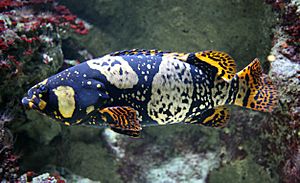Giant grouper facts for kids
Quick facts for kids Giant grouper |
|
|---|---|
 |
|
| Giant grouper at Ripley's Aquarium of Canada | |
| Conservation status | |
| Scientific classification | |
| Synonyms | |
|
The giant grouper (Epinephelus lanceolatus) is a huge ray-finned fish. It is also known as the Queensland grouper or brindle grouper. This amazing fish belongs to the grouper family, which also includes sea basses. It lives in many parts of the Indo-Pacific Ocean. The giant grouper is one of the biggest bony fish species alive today.
Contents
About the Giant Grouper
The giant grouper has a very strong body. Its body length is about 2.4 to 3.4 times its height. The top of its head is rounded. It has a rounded gill cover with small bumps.
This fish has two main fins on its back. The first one has 11 stiff spines. The second one has 14 to 16 soft rays. Its anal fin, located underneath, has 3 spines and 8 soft rays. The tail fin is slightly rounded. It has 54 to 62 scales along its lateral line (a line of special scales that helps fish sense movement).
Adult giant groupers are grey-brown with a mottled pattern. Their fins are darker. Young groupers are bright yellow with wide, dark stripes. They also have dark spots on their fins. This fish can grow very large. The longest one ever recorded was about 270 centimeters (almost 9 feet) long! They usually weigh around 400 kilograms (about 880 pounds).
Where Giant Groupers Live
The giant grouper lives in many places around the world. It is the most widespread grouper species. You can find it from the Red Sea and eastern Africa all the way to the Pacific Ocean. It lives as far east as the Pitcairn Islands and Hawaii.
They are found north of Japan and south of Australia. In Australia, they live along the tropical coasts. This includes places like Western Australia and New South Wales. They also live near Christmas Island and Cocos (Keeling) Islands. Sometimes, they are seen near New Zealand. They are not found in the Persian Gulf.
Habitat and Behavior
Giant groupers live in shallow waters. They can be found from 1 meter (3 feet) to 100 meters (330 feet) deep. They love coral reefs and are the biggest bony fish living there. Very large groupers have been caught near shores and in harbors.
They often hide in caves or shipwrecks. Young groupers are shy and stay hidden in reefs. Adult groupers usually live alone. They claim their own areas on the outer reef and in lagoons. They have also been found in muddy waters by prawn fishermen.
The giant grouper is a clever hunter. It waits quietly and then ambushes its prey. They eat many kinds of fish, small sharks, and young sea turtles. They also eat crabs and other shellfish. They swallow their food whole! For example, a grouper caught near Hawaii had two spiny lobsters and many crabs in its stomach. Groupers in South Africa mostly eat a type of crab called Scylla serrata.
These fish are usually solitary and live for a long time. They are also curious and sometimes swim close to divers. While they are not usually dangerous, divers should be careful around very large ones. It is best not to feed them by hand.
Reproduction and Life Cycle
Like most groupers, giant groupers can change their sex. This means they are protogynous hermaphrodites. They start as females and can later become males.
They lay their eggs based on the moon's cycle. Spawning events usually last about 7 days. Many groupers gather together to release their eggs and sperm into the water. This is called "broadcast spawning." Usually, several females will spawn with one male.
At the start of spawning, the main male and female do most of the egg fertilizing. But as the event continues, other groupers in the group also help fertilize eggs. Even males who have only recently changed from female to male can father offspring. Some males are born as males and never go through a female stage.
History and Classification
The giant grouper was first officially described in 1790. A German doctor and naturalist named Marcus Elieser Bloch gave it the scientific name Holocentras lanceolatus. He found it in the Malay Archipelago (East Indies).
Later, scientists grouped the giant grouper with the goliath groupers. They were put into a genus called Promicrops. But in 1972, this was changed to be a subgenus of Epinephelus. Even so, these species are still very closely related.
How People Use Giant Groupers
The giant grouper is a very valuable fish for food. Both commercial fishermen and people fishing for fun catch them. Besides eating their meat, some parts like their skin, gall bladder, and stomach are used in Traditional Chinese Medicine.
In Hong Kong, smaller giant groupers are especially popular. They are sold alive for the live reef food fish trade. This species is also raised in fish farms, which is called mariculture. This practice is common, but it's hard to get enough young groupers. However, fish farms in Taiwan have successfully raised young groupers. They even export some to other parts of Southeast Asia to be grown. Many of the fish raised in these farms are actually hybrids. They are a mix between the giant grouper and another species called Epinephelus fuscoguttatus.
See also
 In Spanish: Mero gigante para niños
In Spanish: Mero gigante para niños



